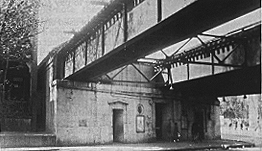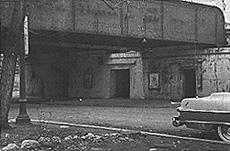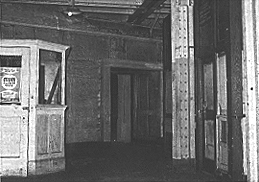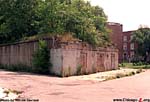
The Lake Park (east)
entrance to Ellis-Lake Park in October 1955. Note that,
here, the Chicago Junction Railway is on a separate deck
girder here. (Photo by George
Macak, from the Collection of George
Krambles)
|

The Ellis (west) entrance to
Ellis-Lake Park in November 1955. Already, dilapidation had
set in. Except for the pediments over the side doors, the
station entrances were quite utilitarian.
(Photo by George Macak, from the
Collection of George Krambles)
|
Ellis-Lake Park
(1000E/4100S)
41st Street, between Ellis
Avenue and Lake Park Avenue, Kenwood (Oakland)
Service
Notes:

|
Kenwood
Line
|
Quick Facts:
Address: TBD
Established: September 20, 1907
Original Line: South Side Elevated, Kenwood branch
Previous Names: none
Skip-Stop Type: n/a
Rebuilt: n/a
Status: Demolished
History:
This simple concrete-and-steel station was typical of those found
on the Kenwood branch. Its concrete island platform floor and simple
canopy latticework suited the largely unoccupied neighborhood at the
time of its construction. The station houses below (one at the east
end of station at Lake Park, the other at the west end at Ellis) were
inside the embankment. Never lavish by any standards, their
exterior's were plain concrete with three doors (the main
double-doors in the center flanked by two smaller doors) decorated
only by a simple pediment over each entrance. Inside, amenities were
minimal or nonexistent. The walls were concrete or (usually
badly-water damaged) plaster with some wood moldings. Lighting was
incandescent and the interior was broken up by naked steel I-beams.
Only a simple wooden fare booth usually broke up the floor space.
Developers responded to the new line by building elegant new
apartments and converting single family dwellings into multifamily
boarding houses. During this early development, the neighborhood was
quite white collar, including many German Jews, Irish and English
workers. By the 1930s, an increasing number of transients and single
persons populated the neighborhood, followed by large numbers of
African Americans in the 1940s. Stock Yards workers were common here
too.
The CTA's abandonment of the Kenwood line has an interesting
twist. Most stations and lines were abandoned outright due to low
usage or low profitability. As it turned out, the embankment and
right-of-way that line was one actually belonged to the Chicago
Junction Railway, a single track railroad that ran along side it that
connected the Illinois Central and a number of other lines to the
Stock Yards. In early 1956, they demanded the CTA start paying them
$100,000 yearly rent; rental payments had been discontinued in 1937
by the CRT. Operating loses on the line were $200,000. No agreement
could be reached, so Mayor Daley stepped in and a deal was worked out
in which the CTA would pay a token rent of $1,000 a month until a
deal was worked out.
In addition to these issues, by the mid-1950s it was becoming
apparent that falling ridership and increasing deterioration of the
Kenwood Line would require some sort of immediate action. Three plans
were formulated for how to continue service - purchasing the route
from the Chicago Junction Railway (from whom CTA rented the
property), leasing it from the CJRwy, and purchase by an outside
agency for CTA use - but all of these included modernization of the
Kenwood stations. As part of a $3,100 modernization plan covering
both the Kenwood and Stock Yards Lines, drawings dated July 13, 1956
show that the CTA planned to minimize and streamline the stations to
achieve maximize usage with as little operations costs as possible.
The two side doors of the Lake Park entrance were to be sealed with
transite and the doors of the center passage were to be removed.
Floor-to-ceiling cornerless transit walls were to be used to
partition off the interior of the station house, creating only a
passageway from the door up to the stairs to the platform. Lamps were
to be upgraded to a higher wattage for better security and new fare
controls were to be installed. Only half the platform and canopy were
to be retained. The Ellis station house and the half of the platform
nearest to it were to be sealed off and abandoned.
Despite all of these efforts and plans, ridership was deemed too
low and costs too high to continue service on this lightly used line.
No deal with the Chicago Junction Railway was worked out and service
was discontinued on the Kenwood branch on December 1, 1957.

|
Left: The interior of
the Ellis station in November 1955. Neglect by the CTA had
caused serious dilapidation to set in. In the window of the
agents' booth is a placard for the Mum flower show,
accessible by CTA lines, of course.
(Photo by George Macak, from the Collection of George
Krambles)
|


|
ellis-lakepark.lakepark01.jpg
(86k)
Although the bridge decking is done, the Lake Park entrance
to Ellis-Lake Park is still largely extant in this view
looks northwest on May 11, 2002. Of the three doorways into
the station house in the embankment (also still extant), two
are bricked over but one only has a metal gate, allowing a
view inside. (Photo by Andrew
Stiffler)
|

|
ellis-lakepark.lakepark02.jpg
(90k)
Looking east along 41st Street at the Lake Park
entrance to Ellis-Lake Park on May 11, 2002. The two bricked
over doorways led into the station house; the lush foliage
on the embankment is the former
"L"TM and Chicago Junction
rights-of-way. (Photo by Andrew
Stiffler)
|

|
ROW@LakePark.jpg
(642k)
Although the bridge decking is gone, the Lake
Park entrance to Ellis-Lake Park is still largely extant in
this view looking west in 2000. Of the three doorways into
the station house in the embankment (also still extant), two
are bricked over but one only has a metal gate, allowing a
view inside. (Photo by William
Davidson)
|

|
ROW@Ellis_SE.jpg
(421k)
Looking southeast from the corner of 41st Street
(parallel to the embankment) and Ellis Avenue at the Ellis
entrance to the now-derelict Ellis-Lake Park station of the
Kenwood branch in 2000. (Photo by William
Davidson)
|

|
ROW@Ellis_east.jpg
(507k)
Looking east at the abandoned Ellis entrance to
the former Ellis-Lake Park station in 2000. The entrance to
the station, embedded in the embankment, is intact, but all
three doorways have been bricked over. Small elements of
decoration are evident in the casting of the concrete.
(Photo by William Davidson)
|
|

|

|










